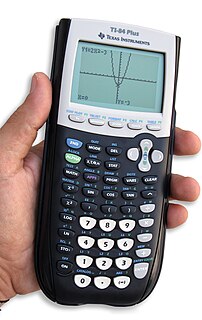 W
WA graphing calculator is a handheld computer that is capable of plotting graphs, solving simultaneous equations, and performing other tasks with variables. Most popular graphing calculators are also programmable and therefore considered to be programmable calculators, allowing the user to create customized programs, typically for scientific, engineering and education applications. Because they have large displays in comparison to standard four-operation handheld calculators, graphing calculators also typically display several lines of text and calculations at the same time.
 W
WThe Casio CFX-9850G series is a series of graphing calculators manufactured by Casio Computer Co., Ltd. from 1996 to 2008.
 W
WThe Casio Algebra FX series was a line of graphing calculators manufactured by Casio Computer Co., Ltd from 1999 to 2003. They were the successor models to the CFX-9970G, the first Casio calculator with computer algebra system, or CAS, a program for symbolic manipulation of mathematical expressions. The calculators were discontinued and succeeded by the Casio ClassPad 300 in 2003.
 W
WThe Casio ClassPad 300, ClassPad 330 and fx-CP400 are stylus based touch-screen graphing calculators. The ClassPad comes with a collection of applications that support self-study, like 3D Graph, Geometry, eActivity, Spreadsheet, etc. A large 160x240 pixel LCD touch screen enables stylus-based operation. The ClassPad resembles Casio's earlier Pocket Viewer line. HP and Texas Instruments attempted to release similar pen based calculators (the HP Xpander and PET Project, but both were cancelled before release to the market.
 W
WThe Casio FX-7000G is a calculator which is widely known as being the world's first graphing calculator available to the public. It was introduced to the public and later manufactured between 1985 and c. 1988. Notable features are its ability to graph functions, and that it is programmable. The calculator offers 82 scientific functions and is capable of manual computation for basic arithmetic problems.
 W
WGraphic calculators made by Casio include the touchscreen ClassPad 300 as well as the models with traditional buttons which can be divided into two main generations listed below. Casio produced the world's first graphing calculator, the fx-7000G.
 W
WThe hp 9g (F2222A) is a graphing calculator designed by Kinpo Electronics, Inc and produced by Hewlett-Packard. It has basic graphing, scientific and programming features designed for use by students.
 W
WThe HP 38G is a programmable graphing calculator by Hewlett Packard. It was introduced in 1995 with a suggested retail price of 80 USD. HP credits a committee of eight high school, community college, and university teachers with assisting in the design of the calculator.
 W
WThe HP 48 is a series of graphing calculators using Reverse Polish Notation (RPN) and the RPL programming language, designed and produced by Hewlett-Packard from 1990 until 2003. The series includes the HP 48S, HP 48SX, HP 48G, HP 48GX, and HP 48G+, the G models being expanded and improved versions of the S models. The models with an X suffix are expandable via special RAM and ROM cards. In particular, the GX models have more onboard memory than the G models. The G+ models have more onboard memory only. The SX and S models have the same amount of onboard memory.
 W
WThe HP Prime is a graphing calculator introduced by Hewlett-Packard in 2013 and currently manufactured by HP Inc. It was designed with features resembling those of smartphones, such as a full-color touchscreen display and the ability to expand functionality by means of downloadable applications. It claims to be the world's smallest and thinnest CAS-enabled calculator currently available.
 W
WThe HP Xpander (F1903A) aka "Endeavour" was to be Hewlett-Packard's newest graphing calculator in 2002, but the project was cancelled in November 2001 months before it was scheduled to go into production. It had both a keyboard and a pen-based interface, measured 162.6 mm by 88.9 mm by 22.9 mm, with a large grayscale screen, and ran on two rechargeable AA batteries. It had a semi-translucent green cover on a gray case and an expansion slot.
 W
WThe HP-28C and HP-28S were two graphing calculators produced by Hewlett-Packard from 1986 to 1992. The HP-28C was the first handheld calculator capable of solving equations symbolically. They were replaced by the HP 48 series of calculators, which grew from the menu-driven RPL programming language interface first introduced in these HP-28 series.
 W
WThe Texas Instruments signing key controversy resulted from Texas Instruments' (TI) response to a project to factorize the 512-bit RSA cryptographic keys needed to write custom firmware to TI devices.
 W
WThe TI 73 series is a series of graphing calculators made by Texas Instruments, all of which have identical hardware.
 W
WThe TI-80 is a graphing calculator made by Texas Instruments. It was originally designed in 1995 to be used at a middle school level.
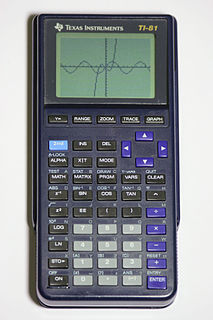 W
WThe TI-81 is an early graphing calculator made by Texas Instruments. It was designed in 1990 for use in algebra and precalculus courses. Since its original release, it has been superseded several times by newer calculators: the TI-85, TI-82, TI-83, TI-86, TI-83 Plus, TI-83 Plus Silver Edition, TI-84 Plus, TI-84 Plus Silver Edition, and most recently the TI-Nspire and TI-Nspire CAS. Most of these share the original feature set and 96×64-pixel display that began with this calculator.
 W
WThe TI-82 is a graphing calculator made by Texas Instruments. The TI-82 was designed in 1993 as a stripped down, more user friendly version of the TI-85, and as a replacement for the TI-81. It was the direct predecessor of the TI-83. It shares with the TI-85 a 6 MHz Zilog Z80 microprocessor. Like the TI-81, the TI-82 features a 96x64 pixel display, and the core feature set of the TI-81 with many new features.
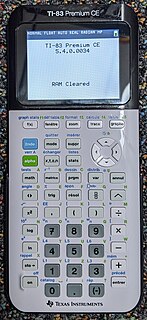 W
WThe TI-83 Premium CE is a color graphing calculator, released on January 15, 2015 by TI France. It is the French equivalent of the TI-84 Plus CE, with translated key labels, a French-specific exam mode, and an "exact math" engine.
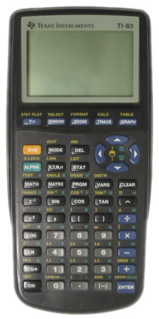 W
WThe TI-83 series is a series of graphing calculators manufactured by Texas Instruments.
 W
WThe TI-84 Plus is a graphing calculator made by Texas Instruments which was released in early 2004. There is no original TI-84, only the TI-84 Plus, the TI-84 Plus Silver Edition models, and the TI-84 Plus CE. The TI-84 Plus is an enhanced version of the TI-83 Plus. The key-by-key correspondence is relatively the same, but the 84 features some improved hardware. The archive (ROM) is about 3 times as large, and CPU about 2.5 times as fast. A USB port and built-in clock functionality were also added. The USB port on the TI-84 Plus series is USB On-The-Go compliant, similar to the next generation TI-Nspire calculator, which supports connecting to USB based data collection devices and probes, and supports device to device transfers over USB rather than over the serial link port..
 W
WThe TI-85 is a graphing calculator made by Texas Instruments based on the Zilog Z80 microprocessor. Designed in 1992 as TI's second graphing calculator, it was replaced by the TI-86, which has also been discontinued.
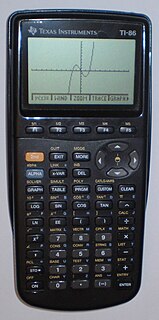 W
WThe TI-86 is a programmable graphing calculator introduced in 1996 and produced by Texas Instruments. The TI-86 uses the Zilog Z80 microprocessor. It is partially backwards-compatible with its predecessor, the TI-85.
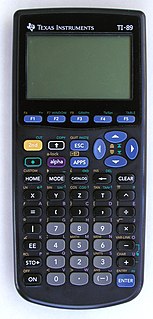 W
WThe TI-89 and the TI-89 Titanium are graphing calculators developed by Texas Instruments (TI). They are differentiated from most other TI graphing calculators by their computer algebra system, which allows symbolic manipulation of algebraic expressions—equations can be solved in terms of variables, whereas the TI-83/84 series can only give a numeric result.
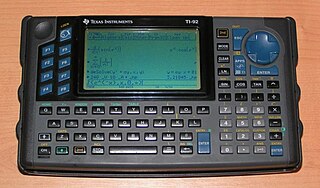 W
WThe TI-92 series of graphing calculators are a line of calculators produced by Texas Instruments. They include: the TI-92 (1995), the TI-92 Plus, and the Voyage 200 (2002). The design of these relatively large calculators includes a QWERTY keyboard. Because of this keyboard, it was given the status of a "computer" rather than "calculator" by American testing facilities and cannot be used on tests such as the SAT or AP Exams while the similar TI-89 can be.
 W
WThe TI-Nspire is a graphing calculator made by Texas Instruments which was released in July 2007. The original TI-Nspire was developed out of the TI PLT SHH1 prototype calculator, the TI-92 series of calculators released in 1995, and the TI-89 series of calculators released in 1998. The TI-Nspire features a non-QWERTY keyboard and a different key-by-key layout compared to its predecessors. The TI-Nspire allows users to swap out the existing removable keypad with a functional copy of the TI-84 Plus series keypad. The TI-Nspire series I/O has a connector for the TI-Nspire Lab Cradle, another that serves as a connector for TI's wireless network adapter, and a Mini-USB connector for transferring data. The TI-Nspire series is available with and without a computer algebra system.